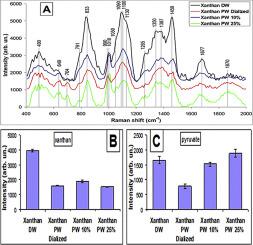Journal of Photochemistry and Photobiology B: Biology ( IF 3.9 ) Pub Date : 2020-10-09 , DOI: 10.1016/j.jphotobiol.2020.112052 Igor C.F. Sampaio , Pedro J.L. Crugeira , Luiz G.P. Soares , Jacson N. dos Santos , Paulo F. de Almeida , Antonio L.B. Pinheiro , Landulfo Silveira

|
Produced water (PW) is a by-product generated throughout oil exploration. Geological formation and geographical location of the reservoir influence its physical, chemical and biological characteristics. Xanthan gum (XG), an exopolysaccharide (EPS) produced by Xanthomonas campestris, has been widely used in enhanced oil recovery (EOR) technology because of its high viscosity, pseudoplastic behavior, stability in function of salinity, temperature and alkaline conditions. The production of XG may be affected by the composition of the PW, where the acetyl and pyruvyl radicals may be present in the mannoses. The aim of this study was to evaluate the composition of XG produced by X. campestris, particularly the amount of Xanthan, acetyl and pyruvyl groups, in culture mediums containing distilled (DW) or produced (PW) water in different concentrations, by means of dispersive Raman spectroscopy (1064 nm). The spectra of XG showed peaks referred to the main constituents of the Xanthan (glucose, mannose and glucuronic acid). Spectral features assigned to pyruvyl were seen in all samples mainly at ~1010 cm−1, with higher intensity when using DW and 25% PW. PCA loadings showed that the peaks assigned to pyruvyl are consistent to presence of sodium pyruvate (~1040/~1050 and ~ 1432 cm−1) and were higher in the samples obtained in 25% PW. ANOVA GLM applied to Raman peaks of interest (~1010 and ~ 1090 cm−1) and to PCA scores (Score 1 to Score 3) showed that both were influenced by the type of water used in the culture medium, where the XG were strongly reduced in the groups PW compared to DW while the pyruvyl content increased proportionally with the concentration of PW. The results suggest that the composition of the water used in the bacteria's culture medium influenced the composition of XG, including the amount of Xanthan and particularly the pyruvyl content, and therefore needs to be considered when using this approach of injecting XG in oil fields as pyruvyl content affects viscosity.
中文翻译:

Xanthomonas campestris生产的黄原胶的成分,该碳黄原胶是使用碳酸化油田的采出水通过拉曼光谱法生产的
产出水(PW)是整个石油勘探过程中产生的副产品。水库的地质构造和地理位置影响其物理,化学和生物学特性。黄原胶(XG)是一种由黄单胞菌(Xanthomonas campestris)生产的胞外多糖(EPS),因其高粘度,假塑性行为,盐度,温度和碱性条件下的稳定性而被广泛用于增强采油率(EOR)技术。XG的产生可能受到PW组成的影响,其中甘露糖中可能存在乙酰基和丙酮基。这项研究的目的是评估X. campestris生产的XG的组成。通过分散拉曼光谱法(1064 nm),在含有不同浓度蒸馏水(DW)或采出水(PW)的培养基中,尤其是黄原,乙酰基和丙酮基的含量。XG的光谱显示出涉及黄原胶的主要成分(葡萄糖,甘露糖和葡萄糖醛酸)的峰。在所有样品中均可见到归于丙酮基的光谱特征,主要在〜1010 cm -1处,使用DW和25%PW时强度更高。PCA加载量表明,分配给丙酮基的峰与丙酮酸钠的存在相符(〜1040 /〜1050和〜1432 cm -1),并且在以25%PW所得的样品中更高。将ANOVA GLM应用于感兴趣的拉曼峰(〜1010和〜1090 cm -1)和PCA得分(得分1至得分3)均表明两者均受培养基中所用水类型的影响,与DW相比,PW组中的XG大大降低,而丙酮酸含量随浓度成比例增加PW。结果表明,细菌培养基中使用的水的组成会影响XG的组成,包括黄原胶的含量,特别是丙酮基含量,因此在油田中使用这种将XG注入丙酮中的方法时需要考虑含量会影响粘度。











































 京公网安备 11010802027423号
京公网安备 11010802027423号